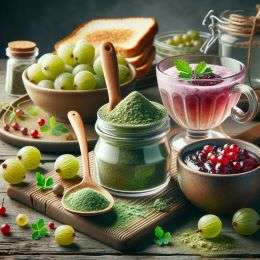This post contains affiliate links, through which we may earn a commission at no additional cost to you.
Table of Contents
Introduction
Turning your garden into a sanctuary of flavor and aesthetics can be done without plants from far-off territories. The secret to creating a lively and multifunctional garden might be adding wild berries. These earthly treasures offer double the benefits: they elevate your garden’s visual charm with their vibrant fruits and blossoms and promise an exciting culinary journey. Here are seven wild berries to infuse your garden space with allure and taste.
Blackberry: The Wandering Rebel
The garden harbors the wild blackberry, with its untamed vines and spiky stems, serving as both a test and a treat for the careful gardener. Packed with taste and benefits, these hardy fruits demand a mix of attentiveness and strategy to cultivate successfully. Nonetheless, the payoff from your endeavors is highly satisfying. Find strategies to subdue these wandering rebels, innovative recipes, and product suggestions to capture their unruly essence.
Plantation Guidance and Maintenance
- Selection is Key: Choose thorn-free variations for a smoother gardening adventure. These types are equally fruitful and more accessible to pick from.
- Room to Roam: Blackberries favor their space. Space the canes 4-6 feet apart within rows 8-10 feet apart, permitting them ample room to flourish without knotting.
- Craving Light and Rich Soil: Blackberries are sun-lovers, necessitating a spot basked in 6-8 hours of sunlight daily. Although not very particular about soil, they prosper in rich, well-drained loam with a pH between 5.5 and 7.
- Trimming for Abundance: It’s vital to prune regularly. Eliminate any deceased canes and thin out the plants to boost airflow. This promotes vigorous growth and more fruit.
- Moisture and Weed Control: A substantial layer of mulch helps keep moisture, deter weeds, and shield roots. Ensure the soil remains damp but not soppy, especially while fruiting.
Inventive Recipes
- Blackberry & Lavender Sorbet
- Ingredients
- 2 cups of fresh blackberries, 1 cup of sugar, 2 cups of water, 1 tablespoon of dried lavender flowers.
- Instructions
- Cook blackberries, sugar, water, and lavender together in a pot until the berries disintegrate.
- Filter to eliminate seeds and lavender.
- Use an ice cream machine to freeze.
- Enjoy this aromatic, refreshing treat that embodies summertime.
- Ingredients
- Zesty Blackberry Glaze:
- Ingredients
- 1 cup of blackberry purée, ¼ cup of balsamic vinegar, 2 tablespoons of soy sauce, 1 tablespoon of honey, 1 minced garlic clove.
- Directions
- Mix everything in a pot and simmer until it thickens.
- This glaze is perfect for adding a tangy, sweet, and savory dimension to grilled meats or vegetables.
- Ingredients
Three Health Food Products
- Blackberry Infused Raw Honey
- A delightful twist on raw honey infused with the essence of blackberries. It’s like spreading the importance of a summer’s day onto your morning toast or drizzling over yogurt.
- Blackberry Powder
- Freeze-dried and ground into a fine powder, blackberry powder is perfect for adding a nutrient-packed punch to smoothies, oatmeal, or baking recipes. It’s the superhero disguise for blackberries, delivering vitamins and antioxidants in a convenient form.
- Blackberry Tea
- A herbal blend featuring dried blackberries and leaves, offering a soothing, antioxidant-rich beverage option. It’s like receiving a warm hug from a blackberry bush without the thorns.
These blackberry-centric ideas and products showcase the versatility and charm of the wandering rebel of the garden. Whether you’re planting them in your backyard, whipping up a unique dish, or incorporating blackberry products into your daily routine, these tips, recipes, and products will help you harness the adventurous spirit of blackberries.
Raspberry: The Spiky Siren
Enchanting in look and taste, Raspberries are the jewels in any berry-rich forest garden‘s crown. Yet, beneath their bewitching appearance is a spiky challenge that requires a gardener’s dedication and tender care. Here are the ways to charm these capricious fruits into giving up their bounty and the distinctive culinary delights and health benefits they bring.
Growing Tips and Maintenance
- Prime Positioning: Raspberries bask in the sunlight, though they’re grateful for some shade in warmer areas during the peak heat of the afternoon. Pick a location bathed in sunlight for 6-8 hours a day.
- Soil Specifications: Fertile, well-draining soil with a pH of 5.5 to 6.5 is ideal for these berries. Adding organic material to your soil can enhance its fertility and drainage capabilities.
- Intelligent Irrigation: A consistent water supply is crucial for raspberries, especially in their fruiting phase, because they don’t tolerate drought. Still, avoiding watering from above is wise to keep leaf diseases at bay.
- Stable Support: As raspberry plants can grow heavy at the top, employing a trellis to support them can simplify harvesting.
- Prudent Pruning: An annual pruning can maximize fruit production. Clear away all dead, sickly, or weak canes, aiming to keep about six vigorous canes per foot of row for red raspberries.
Innovative Raspberry Recipes
- Spicy Raspberry-Chili Sorbet
- Awaken your palate with this bold sorbet.
- Blend 2 cups of raspberries with 1 cup of simple syrup, a tablespoon of lime juice, and 2 teaspoons of finely minced red chili.
- Sieve to remove seeds,
- Then freeze using an ice cream machine for a sweet and zesty concoction, perfect for those craving a refreshing kick.
- Awaken your palate with this bold sorbet.
- Raspberry and Goat Cheese Flatbreads
- Warm your oven to 450°F (230°C). Flatten your preferred pizza dough on a baking sheet, brush a light coating of olive oil, and dot with goat cheese.
- Half-bake for about 10 minutes, then scatter fresh raspberries, thyme, and a honey drizzle before returning to the oven for another 5-7 minutes.
- This delightful blend of flavors serves as an ideal snack or light fare.

Health-Boosting Raspberry Products
- Raspberry Ketone Supplements
- Raspberry ketones, the compounds responsible for the fruit’s inviting scent, are believed to help lose weight by increasing metabolism and fat burning, marketed as a natural solution.
- Raspberry Leaf Tea
- Known for its potential to benefit women’s health, especially during pregnancy, it is said that raspberry leaf tea helps shorten labor and lessen menstrual pains.
- Raspberry Infused Vinegar
- For a refreshing and beneficial twist, immerse fresh raspberries in white or apple cider vinegar for 2-4 weeks. What results is a zesty, fruity vinegar ideal for dressing salads, enhancing marinades, or boosting your metabolism?
Raspberries, the Spiky Sirens of the garden, provide more than delectable fruits; they give rise to various culinary delights and health-focused products that embody their spirit. From the attentive cultivation they demand to the unique recipes and health aids they inspire, raspberries demonstrate the beauty of patience and care in the garden and kitchen.
Blueberry: The Antioxidant Aristocrat
Blueberries, boasting a royal deep blue hue, are not solely a visual delight but also an antioxidant behemoth. They are often referred to as the “Antioxidant Aristocrat,” these distinguished berries deliver a symphony of flavors alongside an abundance of health advantages. Let us venture into the world of blueberries, shedding light on cultivation advice, distinctive recipes, and health-oriented products that celebrate this illustrious fruit.
Planting Tips and Care
- Selection of Location and Sun Exposure: Opt for a spot bathing in sunlight with well-draining and acidic soil. Blueberries flourish under total exposure to the sun, needing a minimum of six to eight hours of unfiltered sunlight for optimal fruit yield.
- Soil Amendment: Target a soil pH ranging from 4.5 to 5.5. Adjust your soil’s pH by incorporating sulfur to reduce it or by employing a specialized acidic planting mix intended for azaleas and rhododendrons, which are also compatible with blueberries.
- Irrigation: Ensure the soil remains moist uniformly, avoiding waterlogged conditions. Given their shallow root systems prone to either drying or waterlogging, applying mulch like pine straw or torn leaves can aid in preserving soil moisture and acidity.
- Trimming: In the late winter, trim the bushes to eliminate branches that are either dead or excessively crowded. This practice promotes robust growth and fruiting. Prioritize shaping an open, vase-like architecture to enhance sunlight penetration and airflow.
Distinctive Recipes
- Blueberry Lavender Ice Cream
- Savor a luxuriously creamy dessert that marries the tangy sweetness of blueberries with lavender’s calming fragrance.
- Ingredients
- 2 cups of fresh blueberries, 1 cup of sugar, 2 cups of heavy cream, 1 cup of whole milk, 1 teaspoon of dried lavender flowers, and 1 teaspoon of vanilla extract.
- Instructions
- Cook blueberries with half the sugar and lavender on medium flame until the berries pop.
- After straining and cooling, whisk together cream, milk, sugar, and vanilla until adequately blended.
- Mix with the blueberry blend. Churn in an ice cream maker, followed by freezing until solid.
- Savory Blueberry Balsamic Glaze
- Elevate your grilled meats or roasted veggies with a glaze that expertly pairs blueberries’ natural sweetness with balsamic vinegar’s tangy richness.
- Ingredients
- 1 cup of blueberries, ½ cup of balsamic vinegar, two tablespoons of honey, with a pinch of salt and black pepper.
- Instructions
- Mix all components in a pot over medium heat. Let simmer until it halves in volume and thickens.
- Puree until smooth for a silky consistency, or leave as-is for a chunkier texture. Gently drizzle over chosen dishes.
- Ingredients
- Elevate your grilled meats or roasted veggies with a glaze that expertly pairs blueberries’ natural sweetness with balsamic vinegar’s tangy richness.
Health Food Products
- Blueberry Antioxidant Superfood Powder
- An adaptable powder crafted from freeze-dried blueberries, ideal for boosting smoothies, yogurt, or oatmeal with nutrients. This product leverages blueberries’ high antioxidant levels, providing an easy method to fold these advantages into your daily nutritional intake.
- Blueberry Infused Organic Green Tea
- Enjoy this refreshing green tea blend’s subtle, sweet undertones of blueberries. It’s a beautiful drink promoting overall health and vitality, loaded with antioxidants from green tea and blueberries. Perfect for a rejuvenating morning beverage or a calming drink in the evening.
- Blueberry Almond Snack Bars
- These snack bars meld blueberries’ natural sweetness with the crispness of almonds, rendering a hearty and healthful snacking choice. With a focus on whole-food ingredients, they’re an excellent source of energy, fiber, and antioxidants, ideally suited for snacking on the move.
By committing to the cultivation and care of blueberries in your garden, trying out unique recipes, and delving into health-centric blueberry products, you can thoroughly exploit the myriad benefits of the “Antioxidant Aristocrat.” Whether in your garden or culinary ventures, blueberries, one of the best wild berries, pledge a regal experience rich in flavor, nourishment, and the pleasure of gardening.
Elderberry: The Magical Elder
Dive into the enchanted realm of elderberries, where age-old wisdom blends seamlessly with contemporary health practices. Elderberries, known for their vibrant purple color and rich historical significance, are more than just a feast for the eyes—they’re a treasure trove of health benefits. Join us on an adventure with this magical elder, from its cultivation in your backyard to its various uses in your kitchen and beyond.
Gardening Insights and Maintenance
- Selecting the Perfect Location: Elderberries flourish in both full sunlight and partial shade. Choose a spot that enjoys at least six hours of daylight daily, ensuring your elderberries bask in the sun’s nurturing embrace.
- Soil and Distance: These berries are adaptable to various soil types and require efficient drainage. Strive for a soil pH ranging from 5.5 to 6.5. Plant them 6 to 8 feet apart, allowing ample space for their branches to spread out.
- Irrigation Insights: Elderberries favor a moist soil environment but despise being waterlogged. Water them deeply to promote robust root growth, especially in times of drought, as if you’re quenching the thirst of a sage.
- Trimming Techniques: It’s time to rejuvenate your plants in late winter with careful pruning. Eliminate any branches that are dead, damaged, or excessively crowded to encourage vibrant growth and a fruitful harvest.
Innovative Recipes
- Elderberry Swirl Pancakes
- Start your day with pancakes transformed by the magic of elderberry syrup.
- Prepare your preferred pancake mix, and as you pour it onto the hot griddle, swirl in some homemade elderberry syrup.
- Once perfectly golden, top them with whipped cream and elderflower petals for a magical breakfast.
- Elderberry Balsamic Glaze
- Take your culinary creations to new heights with an elderberry balsamic glaze.
- Combine 1 cup of elderberry juice, ½ cup of balsamic vinegar, 2 tablespoons of honey, and a rosemary sprig in a saucepan.
- Simmer until it thickens, then drizzle it over roasted veggies, grilled meat, or creamy goat cheese to craft a dish of artistry.
Healthful Products
- Elderberry Immune Support Gummies
- Boost your immune system deliciously with elderberry gummies. These gummies are infused with elderberry extract, vitamin C, and zinc, making them a delightful defense against the common cold and flu. They are popular among both grown-ups and little ones and are readily available online.
- Elderberry Tea Assortments
- Embrace wellness by sipping on elderberry-infused teas. These teas, blended with echinacea, mint, and ginger, serve as a comforting beverage that can soothe a sore throat, aid digestion, and strengthen the immune system. Steep, enjoy, and let elderberries’ magical essence surround you.
- Elderberry Capsule:
- Elderberry capsules offer a seamless solution for those who wish to experience elderberry’s benefits without its flavor. Each capsule delivers a potent dose of elderberry’s antioxidant effects, ideal for enhancing immune health while on the move. These are available online and ready to be incorporated into your daily regimen.
Elderberries mesmerize with their spellbinding charm, enriching your garden’s aesthetics and your body’s defenses. Whether through crafting exquisite meals, enjoying calming teas, or seeking wellness enhancements, elderberries introduce a sprinkle of magic into your existence. Embrace the magical elder and allow its ancient secrets to enrich your modern lifestyle.
Gooseberry: A Time-Honored Tartness
The Gooseberry, boasting a distinctive sour-yet-sweet profile, has always been a treasured element in culinary and gardening spaces. These fruits are not just flavorful explosions but also brim with nutritional value, offering a powerhouse of vitamins and antioxidants. They serve as a multifaceted and healthful component in one’s eating routine. Discover methods to grow these succulent berries, create novel dishes, and find health-centric products that showcase their lively flavor.
Cultivation Tips and Nurturing
- Position and Earth: Gooseberries flourish in moist, loamy soils with a pH of 6.0 to 6.5. Opting for a location that receives plenty of sunlight, though not opposed to some shade, is ideal. Their resilience is especially advantageous in cooler regions where sunshine is a limited resource.
- Embedding in the Earth: The prime time for planting gooseberry plants is the onset of spring. They should be spaced 4-6 feet apart, allowing them room to grow and ensuring air flows freely to stave off fungal ailments. The pit for planting must be double the width and depth compared to the root ball, enhanced with compost, and watered well after planting.
- Trimming and Upkeep: Late winter sees the need for pruning to eliminate wilted or sickly branches and facilitate an open structure, promoting robust growth and fruiting. Being self-pollinating, a single bush could suffice for fruit production; however, possessing several can amplify the harvest.
- Irrigation and Nutrition: Keeping the soil moist consistently is crucial, mainly through the plant’s inaugural year and arid periods. Applying mulch around the base with organic material helps in moisture retention and weed control. An early spring application of a balanced fertilizer is beneficial.
- Pest and Affliction Management: Key threats include the gooseberry sawfly and birds. Shielding the plants with netting from birds and scrutinizing for larvae to remove manually can mitigate these issues. Rotating crops and clearing plant detritus aids in disease prevention.
Innovative Gooseberry Dishes
- Gooseberry and Elderflower Sorbet
- The blend of Gooseberry’s sharpness with the gentle fragrance of elderflower crafts an invigorating summer delicacy.
- Simmer the berries with sugar and a dash of water until they soften.
- After blending into a smooth consistency and straining, mix in elderflower cordial, cool completely, then process in an ice cream machine.
- Garnishing with mint leaves introduces a fresh twist.
- Gooseberry Chutney
- This relish is a sublime partner for cheese or barbecued meats, marrying the Gooseberry’s sourness with sweet and spicy flavors.
- Simmer the berries with onions, raisins, sugar, vinegar, and a concoction of spices such as mustard seeds, ginger, and chili flakes until it thickens.
- Seal in sterilized containers to savor throughout the year.

Gooseberry-Incorporated Health Foods
- Gooseberry Powder
- An excellent way to infuse smoothies, yogurt, or oatmeal with a nutritional punch, this powder, crafted from dehydrated and pulverized gooseberries, preserves the fruit’s rich vitamin C and antioxidants. It offers an effortless mode to revel in its health perks sans the sour taste.
- Gooseberry Jam
- For those inclined towards a sweeter health fare, gooseberry jam blends the nutritional advantages with the delight of a home-crafted preserve. Opting for varieties with lesser added sugar ensures it remains healthy.
- Gooseberry Tea
- Offered by select health food vendors, gooseberry tea, whether as dried berries or blended with various herbs, offers a delightful avenue to benefit from the fruit’s advantages, such as aiding digestion and enhancing immunity.
Embracing gooseberries in your garden, culinary experiments, and dietary practices is not merely about enjoying a tasty fruit but also connecting with a slice of culinary tradition that champions the sustained attractiveness of tart flavors enhanced by contemporary health insights. Whether through the gratification of cultivating them, the pleasure derived from cooking, or the ease of available health products, gooseberries epitomize the persistent charm of tart, customary tastes in our everyday lives.
Currant: The Bright Jewel of Your Garden
Shimmering in shades from dark ruby red to lustrous black and brilliant gold, currants are more than a visual delight. These compact yet powerful berries are loaded with taste and nutrients, serving as a multipurpose jewel in your garden and culinary ventures. Here’s your guide to nurturing these bright jewels, crafting distinctive recipes, and discovering health products that leverage their benefits.
Planting Guidance and Maintenance
- Ideal Location, Ideal Soil: Currants flourish in cooler climates but require around 4-6 hours of sunlight daily. They favor well-drained, loamy soil with a pH near 6.5. Enriching your soil with compost before planting gives them a much-needed nutrient boost.
- Wisdom in Watering: Keeping the soil uniformly moist is essential, mainly through growth and berry production seasons. Applying mulch helps in preserving moisture and keeping the roots cool.
Trimming for Thriving: Pruning is vital for currants to encourage growth and berry production. In the late winter, it’s beneficial to eliminate old branches and declutter areas that are too dense to let sunlight and air flow through. - Strategic Companions: Currants planted near garlic and chives help naturally ward off pests. It’s best to avoid planting close to walnut trees, as they secrete juglone, which could be detrimental to currants.
Inventive Recipes
- Currant and Rosemary Glazed Lamb Chops
- Ingredients
- 8 lamb chops, 1 cup of red currants, 2 tbsp of fresh rosemary (chopped), 2 cloves of garlic (minced), 2 tbsp of balsamic vinegar, and seasonings of salt and pepper as preferred.
- Instructions
- Muddle half of the currants and blend with rosemary, garlic, and vinegar for the glaze.
- Season the lamb chops with salt and pepper, cook them as desired, and apply the glaze in the last minutes of grilling.
- Garnish with the remaining currants for an added pop of flavor and color.
- Ingredients
- Sparkling Currant Jelly
- Ingredients
- 4 cups of currant juice (from about 2 pounds of fresh currants), 4 cups sugar, 2 tablespoons of lemon juice, and 1 packet of pectin.
- Instructions
- Combine currant juice, lemon juice, and pectin in a large pot. Bring to a vigorous boil, stir in sugar, and boil for an additional minute, constantly stirring.
- Take off from the heat, remove any foam, and transfer into sterilized jars.
- This vibrant jelly will surely sparkle in your morning spread or cheese boards.
- Ingredients
Health Food Products
- Currant C Power Smoothie Blend
- This freeze-dried currant powder enhances smoothies, yogurts, or oatmeals with a nutritious kick. Brimming with vitamin C, antioxidants, and fiber, it offers a simple way to bolster your immune and digestive health.
- Black Currant Oil Capsules
- Renowned for their rich gamma-linolenic acid (GLA) content, these capsules are sought after for improving skin health, reducing inflammation, and aiding hormonal balance. Adding them to your daily supplement routine exploits the currant’s anti-inflammatory and beautifying properties.
- Currant Infused Herbal Teas
- Discover online a variety of herbal tea blends that combine the slight tartness of currants with herbs like hibiscus and rosehips. These teas provide an antioxidant-rich drink that supports overall health and can be savored hot or chilled.
Currants, as the bright gems of your garden, present a unique mix of aesthetics, taste, and health advantages. Whether you are meeting their gardening requirements, experimenting with them in your cooking, or trying out health-centric products derived from them, currants brighten your life with their vividness and vitality. Let these versatile berries illuminate your day.
Mulberry: A Giving Giant
The mulberry tree stands out in any garden with its expansive shade and plentiful fruit harvest, serving as a visual delight and an abundant source of delicious, nutrient-packed berries. Here’s how to grow this towering plant and enjoy its rich bounty.
Growing Tips and Maintenance
- Selecting the Ideal Location: Mulberries flourish in sunlight and tolerate some shade. Choose a spot in your garden that is bathed in sunlight and has soil that drains well to allow the tree to establish its roots and branch out.
- Soil and Irrigation: While these trees are not particular about the soil type, they do best in soil with a slightly acidic to neutral pH. Water the saplings consistently to help them develop a deep root system; then, you can ease off; older trees are drought-resistant.
- Trimming and Gathering: Trim the tree in the late winter to keep it in form and to boost berry production. Collect berries by spreading a cloth beneath the tree and lightly shaking the limbs – the ripe fruit will tumble down effortlessly.

Innovative Mulberry Recipes
- Mulberry Lavender Frozen Cream
- Ingredients
- 2 cups of ripe mulberries, 1 cup of heavy cream, 1 cup of whole milk, ¾ cup of sugar, 2 tablespoons of dried lavender, 1 teaspoon of vanilla essence.
- Directions
- Warm the milk, cream, lavender, and half the sugar in a pot until it nearly boils.
- Filter out the lavender. Puree the mulberries with the remaining sugar and vanilla.
- Mix all together and cool.
- Process in an ice cream machine and freeze until solid. A velvety treat with a hint of floral notes!
- Ingredients
- Mulberry Chia Preserve
- Ingredients
- 2 cups of ripe mulberries, ¼ cup of honey or maple syrup, 2 tablespoons of chia seeds, juice from half a lemon.
- Directions
- Crush mulberries in a saucepan on medium flame.
- Mix the sweetener and lemon juice, simmer until the berries are soft.
- Add the chia seeds and stir until it thickens.
- Let it cool before transferring it into jars.
- This preserve is an excellent accompaniment for bread, yogurt, or oatmeal, giving you a wholesome beginning to your day.
- Ingredients
Nutritional Food Items
- Mulberry Tea
- A calming, detoxifying beverage made from dried mulberry leaves. It offers a wealth of vitamins and minerals, aiding in regulating blood sugar and supporting heart health. Whether you prefer loose leaves or tea bags, it provides a pleasant way to savor mulberry advantages all year.
- Mulberry Leaf Extract Supplements
- These are full of antioxidants and come in tablet or liquid format, renowned for their effectiveness in maintaining healthy blood sugar levels and enhancing general health.
- Organic Dried Mulberries
- A sweet, chewy snack that boosts energy instantly. Packed with iron, vitamin C, and fiber, they’re an excellent addition to cereals and salads or consumed independently.
Adding mulberries to your garden and diet allows you to adopt a plant and a heritage of wellness, taste, and happiness. Whether through a delightful serving of ice cream, nourishing jam, or products promoting health, mulberries present a versatile, lavish, unrivaled wealth. Relish the fruits of your effort and the extensive benefits of this giving giant.
Explore the fascinating world of wild berries with these insightful books
- “The Companion to Berry Cultivation” by Barbara L. Bowling
- Barbara L. Bowling’s exhaustive companion is a must-have for those intrigued by cultivating berries, from exotic wild types to more traditional varieties such as strawberries and blackberries. The guide encompasses every aspect from the initial planting and cutting back to controlling pests and gathering crops, delivering actionable insights for beginner and adept gardeners alike. Additionally, it examines the health advantages of berries, positioning it as a comprehensive guide for anyone eager to boost their garden’s productivity and nutritional intake.
- “North America’s Wild Berries & Fruits Field Guide” by Teresa Marrone
- Teresa Marrone has crafted a crucial handbook for wilderness foragers, nature lovers, and wild berry enthusiasts, including those who favor strawberries and blackberries. This guide spans several North American locales and provides intricate descriptions, vivid photographs, and advice on the recognition, collection, and utilization of wild berries. The manual also points out which varieties are edible and which to steer clear of, establishing itself as an indispensable aide for outdoor exploration and incorporating the richness of wild berries into your culinary ventures.
Conclusion
Incorporating wild berries into your garden enhances its beauty and biodiversity and offers a sustainable way to enjoy fresh, organic fruits from your backyard. Whether you’re a seasoned gardener or a beginner, these seven wild berries are a great starting point for creating a garden that delights all the senses.
FAQs
How do you identify if wild berries are poisonous?
To ascertain if wild berries carry toxins, it’s advisable to conduct research, cross-referencing them with trusted guides, or seek advice from a seasoned expert. Typically, poisonous berries exhibit distinct features, including their color, form, and the structure of the plant, which should be carefully observed.
How to dry wild berries?
To dry wild berries, one must wash and gently dab them to remove excess moisture. Then, distribute the berries evenly on a tray and place them into an oven set to a minimal heat, or employ a dehydrator until they are thoroughly dried.
How to grow wild berries?
Selecting a location that mirrors their indigenous surroundings is crucial when cultivating wild berries. Soil preparation should be tailored to meet the specific requirements of the berry. Following this, either seeds or berry plants should be sowed, ensuring they receive the right amounts of sunlight and water to thrive.
How to clean wild berries?
To properly cleanse wild berries, they should be carefully rinsed under cold water. This process helps eliminate any present debris or spoiled berries before their utilization or consumption.








